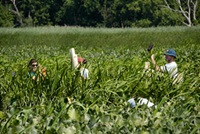Wetlands Research

The Wetlands Section focuses on evaluating the functions and services of tidal freshwater wetlands and brackish and salt marshes, and how these ecosystems are affected by and respond to anthropogenic changes (e.g., sea level rise, mosquito control, nutrient inputs, and climate change). Research includes examining nutrient and carbon cycling, storage in wetland plants and soils, and the exchange of these elements between the plants, soil, water, and atmosphere.
Specific projects within the Wetland and Biogeochemistry sections include the development and coordination of an intensive long-term monitoring program in wetlands along the Delaware Estuary and Barnegat Bay, NJ. The Patrick Center is partnered with two National Estuary Programs, the Partnership for Delaware Estuary and the Barnegat Bay Partnership, along with other federal, state, and academic partners to implement evaluation of elevation, water and soil chemistry, plant composition, and biomass changes over time in over seven wetlands of the Delaware Bay and three wetlands in Barnegat Bay.
Staff

Elizabeth Burke Watson, PhD.
Section Leader
Dr. Elizabeth Watson is a wetland scientist interested in the responses of coastal estuaries and to human impacts and climate change, and the role of wetlands in global biogeochemical cycles. Current projects include the implementation and success of coastal climate-adaptation strategies in southern New England, developing indicators of nutrient enrichment for Long Island, NY estuaries, using CT scans to visualize belowground biomass of wetland plants, toxicological effects of macroalage, and the 150-year reconstruction of cumulative nitrogen pollution in Narragansett Bay, Rhode Island.Click here to see her Google Scholar profile.
Kirk Raper, M.S.
Wetlands Project Coordinator
Mr. Raper is the lead scientist for monitoring marsh elevation change, sediment deposition and accumulation, plant distribution patterns and biomass, soil chemistry, sediment availability and nutrient concentrations in ten coastal wetlands located in Delaware and Barnegat Bays.
Capabilities

- Nutrient and carbon cycling in salt marsh plants and soils
- Belowground organic matter composition and loss through decomposition
- Plant, sediment, and hydrological interactions on surface elevation changes
- Ecotypic or population variation in wetland plants
- Wetland restoration
Facilities


|
The Wetland Section along with the Biogeochemistry section uses a range of field and laboratory equipment including: water quality meters (e.g., YSIs); continuous water level and conductivity recorders; surface elevation tables; particulate carbon and nitrogen analyzer; nutrient auto-analyzer; & various coring supplies.
|
Selected Projects

- Seasonal denitrification in an urban tidal freshwater wetland in Philadelphia, PA
- The effect of Open Marsh Water Management on sedimentation, hydrology, and porewater chemistry in salt marshes
The Wetland Section along with the Biogeochemistry section uses a range of field and laboratory equipment including: water quality meters (e.g., YSIs); continuous water level and conductivity recorders; surface elevation tables; particulate carbon and nitrogen analyzer; nutrient auto-analyzer; & various coring supplies.